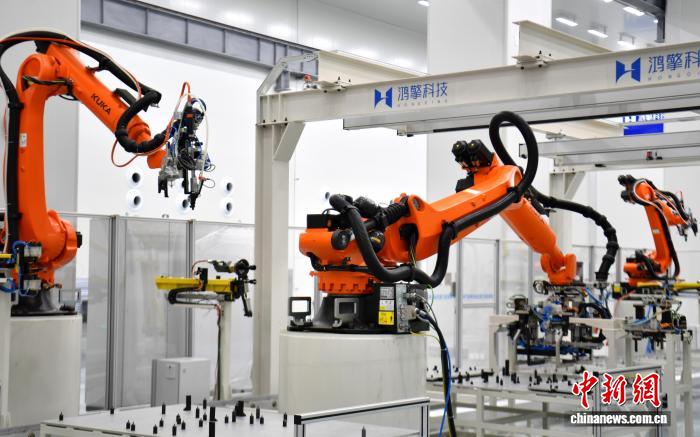Humanoid robots and DeepSeek AI employees deployed in Shenzhen for intelligent grassroots governance

A humanoid robot walks with agile and fluid steps on the streets of Shenzhen. (Photo: Guangdong Fabu)
Artificial intelligence (AI) robots are gaining traction in Shenzhen, South China's Guangdong Province, with a humanoid robot in Nanshan district now serving as a grid-based community worker and police officer. Powered by DeepSeek's advanced large language models, the AI technology is being utilized in Futian district to enhance administrative governance and improve public services.
A video released Monday by the Guangdong Radio and Television's Chudian new media platform showcases a 1.38-meter-tall humanoid robot in a grid-based community worker's uniform assisting with patrols and inspecting streets, while another robot takes on the role of police officer, shaking hands with officers and waving to the crowd.
The robots are developed by Shenzhen EngineAI Robotics Technology Co. A company representative told the Global Times on Monday that the robots featured in the video are one of three humanoid models launched by the company. The latest version, PM01, comes equipped with optimized algorithms for improved stability and real-world performance.
During the Spring Festival holidays, the humanoid robots, equipped with police gear, accompanied officers on patrol in the streets, according to the Shenzhen government website.
The PM01 is 1.38 centimeters tall, weighs about 40 kilograms, and features 24 degrees of freedom (DoF), achieving a movement speed of two meters a second. It is equipped with a 320-degree rotational motor at the waist, allowing it to perform a wide range of complex movements. The robot features two walking modes: a mechanical gait and a natural humanoid gait, the company representative told the Global Times.
This is not the first time that robots have been used for grassroots governance. Previously, a humanoid robot standing 170 centimeters tall, walking with agile and fluid steps on the streets of Shenzhen, went viral. According to a video posted by the official account of the Nanshan District Government, this robot, SE01, was also developed by the same company.
According to EngineAI Robotics Technology, SE01 can perform human-like actions such as squatting, push-ups, spinning, grabbing and running. For the first time globally, it has successfully overcome the challenge of achieving a natural, human-like walking motion. This breakthrough eliminates the awkward small steps, bent legs and stomping movements common in other robots, enabling a smoother, faster, more stable and graceful gait — bringing robots one step closer to human-like mobility.
Many netizens exclaimed, "The robot's walking motion is so natural and realistic!" Others pointed out that as grid workers face the public and handle complex tasks, it's truly great that robots can be used in community grid management.
Robots can alleviate human resource burden in grassroots governance. As is widely known, traditional grassroots governance often requires significant manpower. The introduction of AI and robots can partially replace human labor, Wang Peng, an associate research fellow at the Beijing Academy of Social Sciences, told the Global Times on Monday.
"This allows grassroots personnel to focus more on tasks requiring human intelligence and emotional engagement, such as community care and conflict resolution," Wang added.
The 70 DeepSeek-powered "AI public servants" employed in Shenzhen's Futian district are another example of intelligent grassroots governance, ensuring document format corrections with an accuracy rate of over 95 percent, according to a statement released by the district on Saturday.
The AI employees were built on the full-size DeepSeek R1 model. The 70 digital employees were deployed in 11 functional areas, enhancing efficiency across the government service ecosystem, including document processing, public service, emergency management, as well as business development and investment promotion.
The AI system has reduced the time needed for personalized content generation from five days to just a few minutes. The accuracy of document format corrections exceeds 95 percent, cutting audit times by 90 percent, and the error rate remains below 5 percent.
According to the article, with the assistance of these digital employees, the accuracy in processing public service requests has increased from 70 percent to 95 percent. The safety compliance AI assistant has enhanced rehearsal script generation efficiency by 100 times. The AI investment attraction assistant has streamlined corporate analysis and screening, increasing efficiency by 30 percent. The AI task supervision assistant has boosted cross-departmental task delegation efficiency by 80 percent, and the on-time completion rate has increased by 25 percent.
"Digital employees can significantly improve the efficiency and precision of grassroots governance. They can work around the clock without physiological limitations, responding swiftly to various emergencies," Wang said.
Xiang Ligang, a telecom expert, pointed out that this does not imply AI services will be devoid of human warmth. "When presented with the same facts, these models generate responses that are both engaging and contextually appropriate, enhancing the user experience. This is a valuable aspect," he added.
 最新热点
最新热点
-
阿富汗北部发生6.3级地震 首都震感明显
阿富汗北部发生6.3级地震 首都震感明显
最新热点新华社喀布尔11月3日电(记者张艺缤 胥舒骜)据美国地质调查局地震信息网消息,阿富汗当地时间3日0时58分(北京时间3日4时28分),阿富汗北部巴尔赫省胡勒...
-
独家视频丨习近平乘车抵达庆州博物馆 韩国总统热情迎接
独家视频丨习近平乘车抵达庆州博物馆 韩国总统热情迎接
最新热点当地时间11月1日下午,韩国总统李在明在庆州博物馆为中国国家主席习近平举行欢迎仪式。 总监制丨申勇 监制丨龚雪辉 记者丨史伟 王鹏飞 邢彬...
-
视频丨李在明回答总台记者提问:致力于加强与中国合作
视频丨李在明回答总台记者提问:致力于加强与中国合作
最新热点11月1日,韩国总统李在明在亚太经合组织领导人非正式会议结束后举行记者会,介绍会议成果。在回答中央广播电视总台记者提问时,李在明表示,中韩经济合作至关重...
-
视频丨APEC秘书处执行主任:期待会议上的中国声音
视频丨APEC秘书处执行主任:期待会议上的中国声音
最新热点10月31日,亚太经合组织(APEC)第三十二次领导人非正式会议将在韩国庆州举行。近日,总台记者专访APEC秘书处执行主任佩德罗萨,并梳理了一份会议看点...
-
独家视频丨习近平会见加拿大总理卡尼















 中国央行:前三季度工业中长期贷款保持较快增长
中国央行:前三季度工业中长期贷款保持较快增长
 首颗“雄安造”卫星完成生产下线
首颗“雄安造”卫星完成生产下线
 中国生成式人工智能用户规模达5.15亿人
中国生成式人工智能用户规模达5.15亿人
